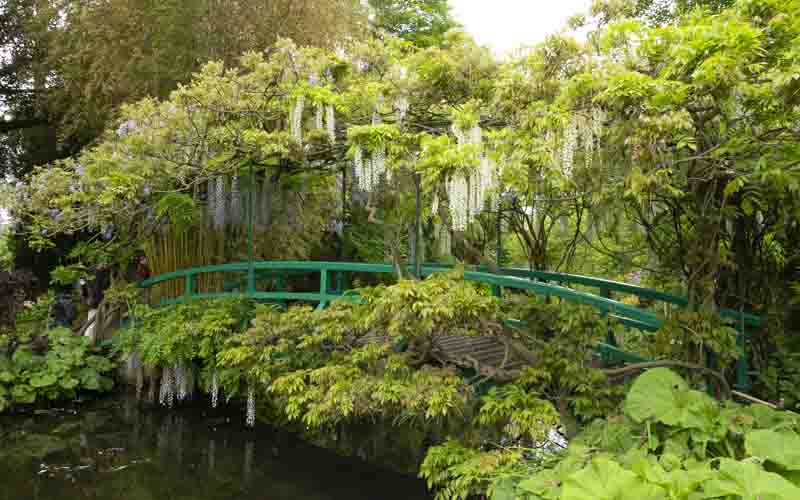
It can be risky to review a garden with a big reputation. When that garden is as well known as Claude Monet’s garden at Giverny, the risk is enormous. Will I like it? Everyone else does, so why should I be different? Certainly I knew what to expect: the iconic Japanese bridge, floating waterlilies, rows of perennials. How many paintings have I seen of these? Dozens, I’m sure.
So although I was happy to visit the garden, I wasn’t really eager. I didn’t want to be disappointed, and I was afraid I would be. I knew that crowds would be a problem, but would they be large enough to ruin any possibility of understanding the garden as it was meant to be understood, as a place of peace and tranquillity? The timed entries and line-ups outside the entrance made that seem likely.
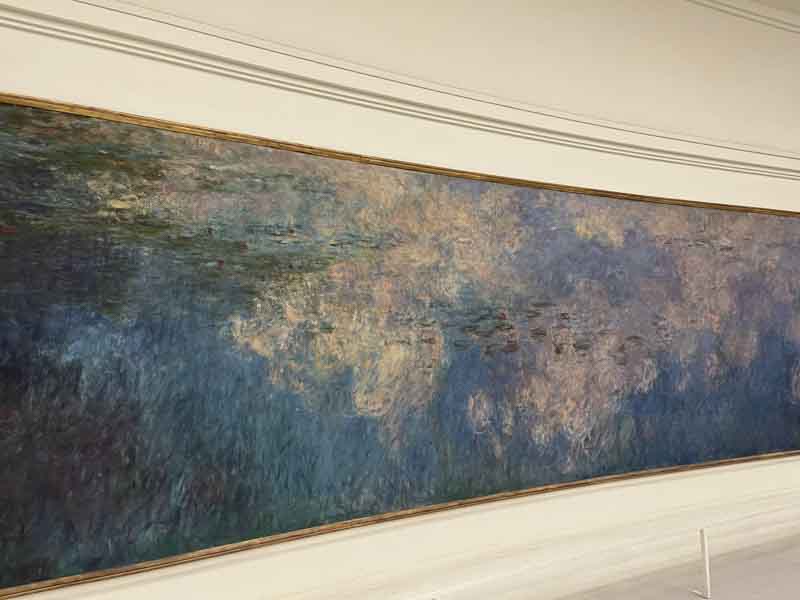
One of Monet’s paintings seen at the Orangerie shows clouds and waterlilies reflected in the water.
The garden has two distinct parts, the Japanese or waterlily pond garden and the French garden. Following the advice we’d been given, our group of four decided to visit the water garden first. Walking through this underground passage to reach it, I shuddered. Crowds were going to be a problem, as were umbrellas: the day was cloudy with a light but persistent rain.

The gap in the line heading towards the water garden exists only because I paused to snap this image.
Crowds lined the paths, walking single file, obediently following their tour guides.
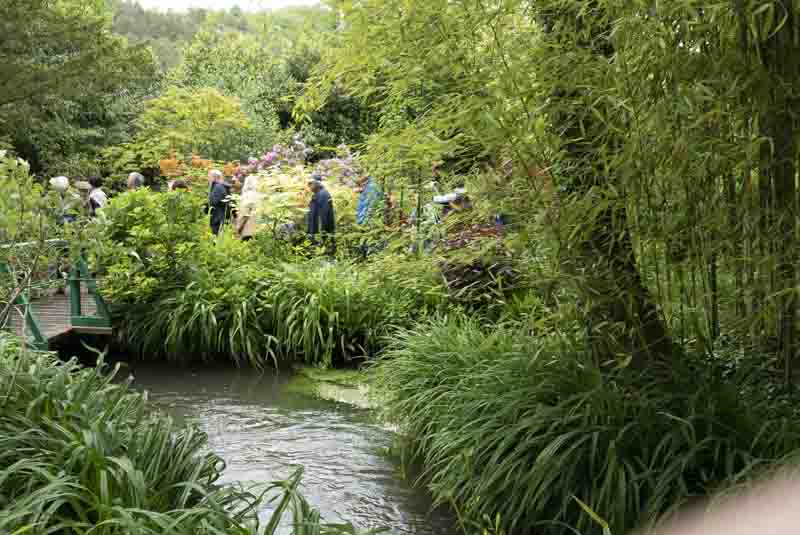
So instead of crossing the bridge and joining the hoards, we continued straight along the stream. And there, for a moment, I caught a glimpse of what the garden could offer.

Amazing, not a body in sight!
Turning the corner, the narrow canal that runs around the central pond led my eye towards a single spot of colour. Beyond an enormous Gunnera, a Japanese maple introduced a tone we would see repeated throughout the garden in various shades of rusty red.
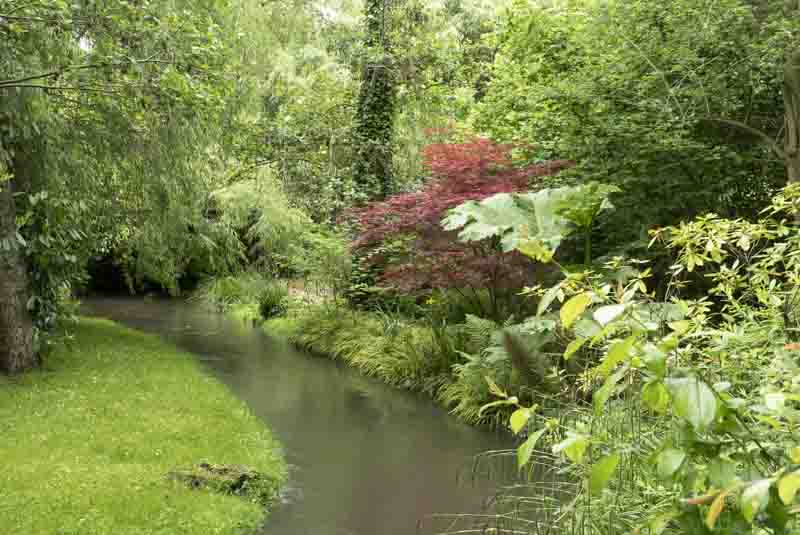
The Japanese maple contrasted nicely with different shades of green.
Dotted alongside the waterlily pond, rusty red shrubs picked up on similar tones in the waterlilies themselves.
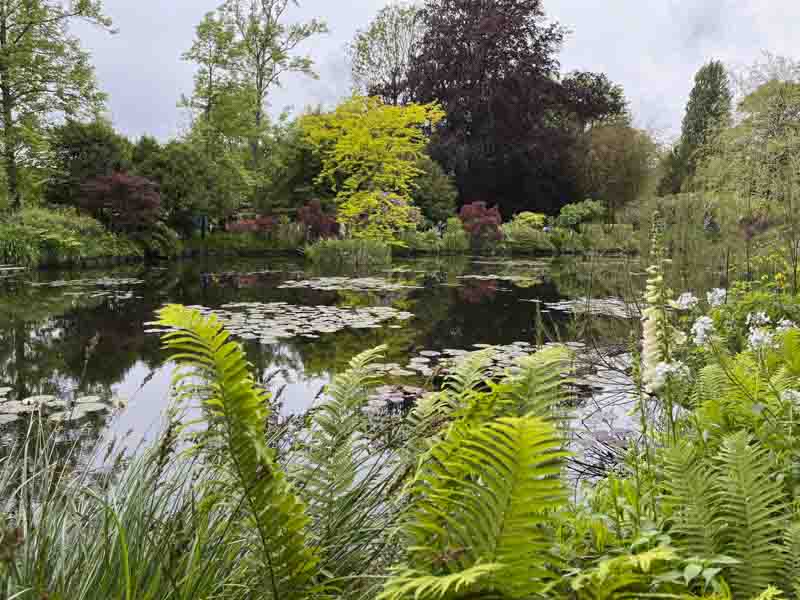
The ferns in the foreground echo the citrus tones of the tree beyond.
The contrast between rusty red and citrus green was striking, whether seen directly or as a reflection in the water. A single branch silhouetted against a smoketree (Cotinus coggygria) was stunning.
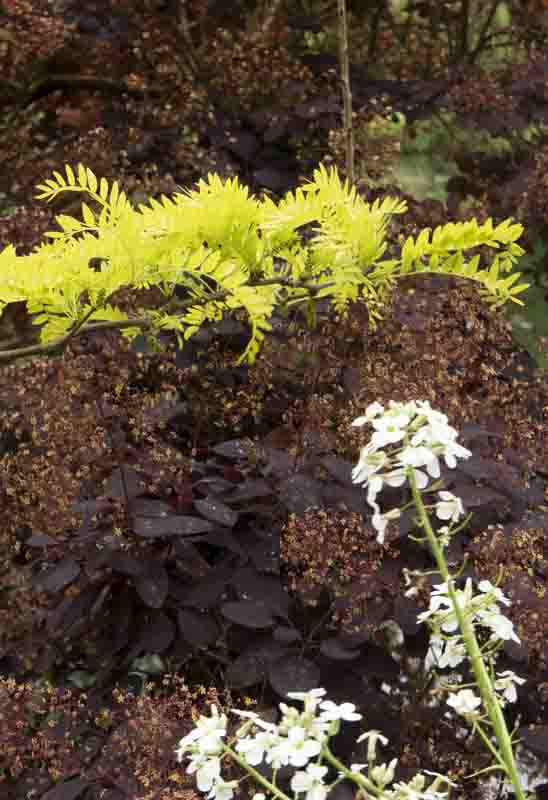
A branch of the same tree hanging over the water was as well. It reinforced quite happily the Japanese theme established by bridges that spanned the water.
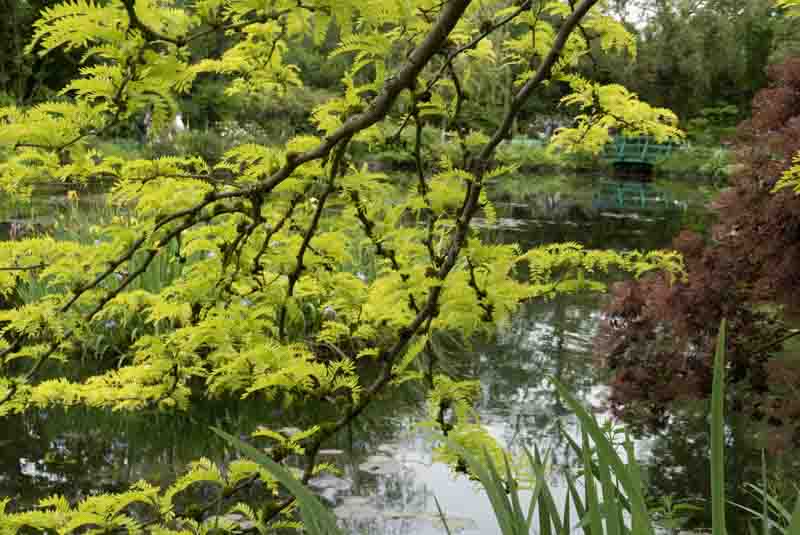
But in those colour contrasts, was there too much of a good thing? If Monet’s intention was to create a peaceful environment, I’d say yes. And did he choose the rhododendron pictured below? If so, who am I, to question the master? But if I could, I would replace it with a different rhodo, one that toned into the brownish red more subtly and linked the contrast between its colour and the citrus beyond.
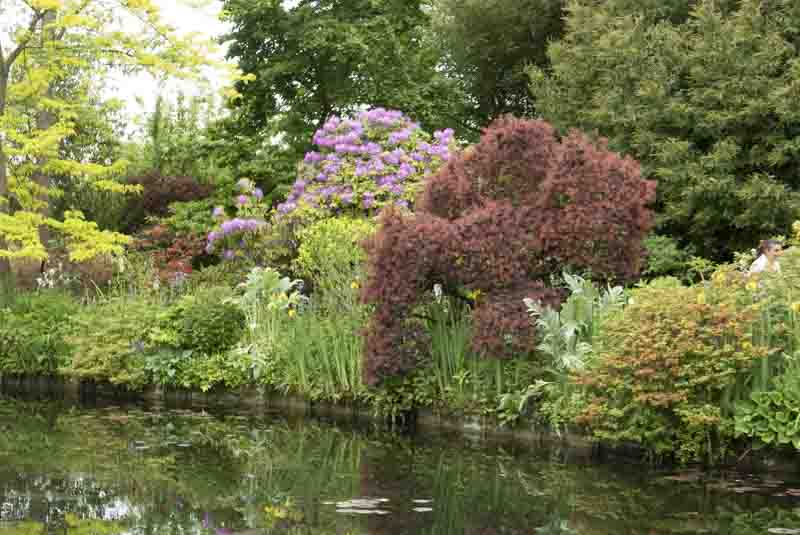
Rhodo delight or rhodo disaster?
Other colour choices surprised me. I liked this lavender on its own.

The dark centres add punch.
I loved this romantically fading tree peony.
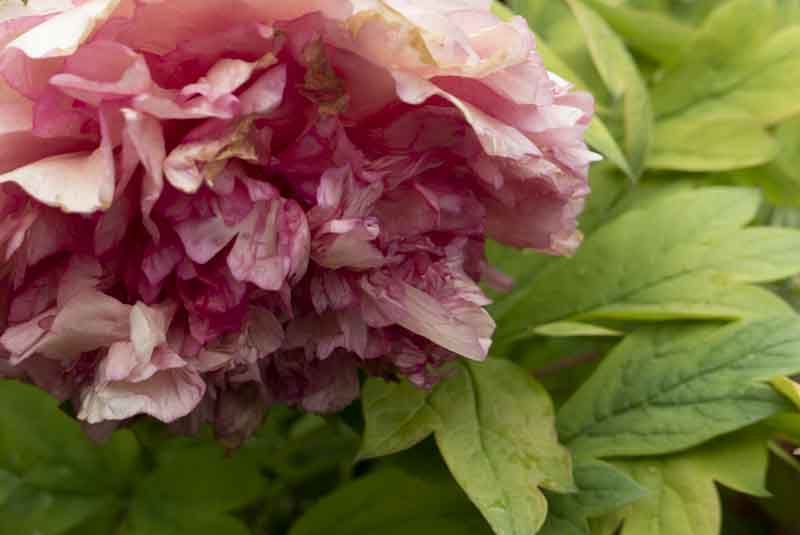
But the orange azalea? No! Not even for variety.

I don’t have a photo of the azaleas around this one but my memory says they were overly colourful.
The most familiar sight at Giverny is the Japanese bridge. When I visited, it was dripping with cameras and crowds as well as wisteria.
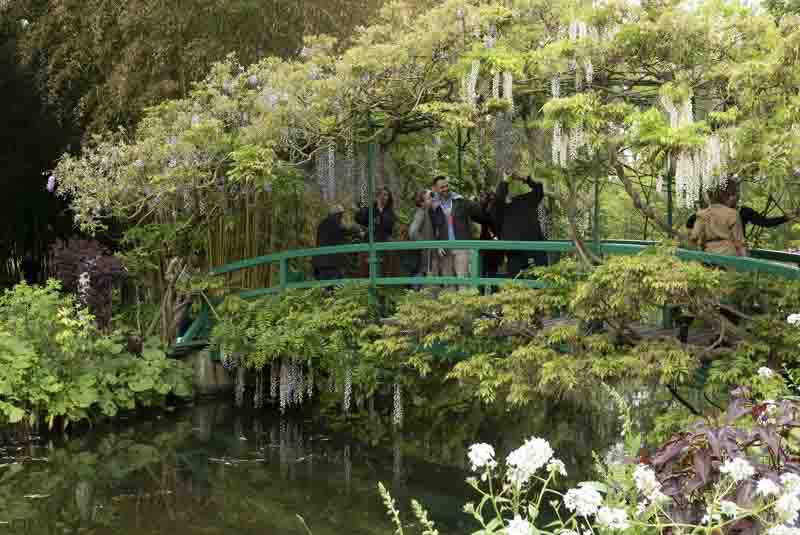
Selfie, anyone?
I had to take a photo of two members of my party — surely that’s obligatory!
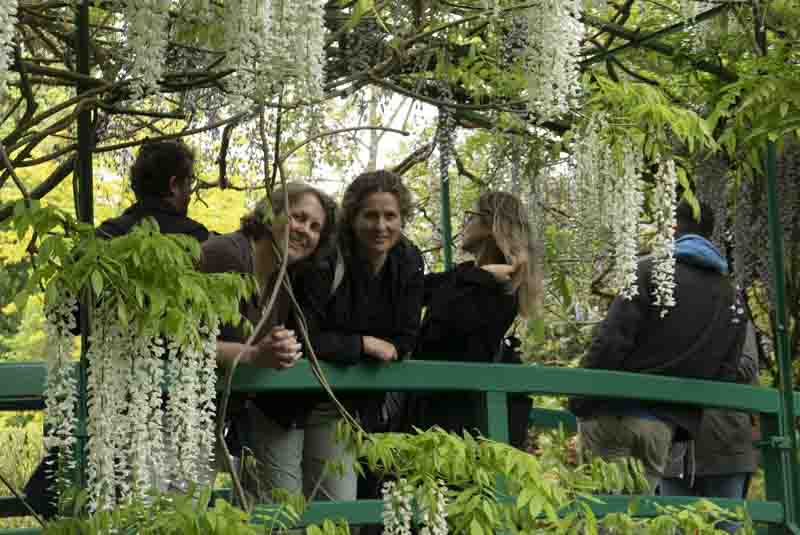
My daughters were great travel companions.
So how can I sum up my experience? Overall, what did I think of the place? My feelings are mixed. There were parts that I liked very much. Almost despite myself, the wisteria draping the bridge was one. The reflections in the water and the arrangement of the waterlilies was another. But there were parts I didn’t like, particularly the strong colour contrasts and the crowds taking photos of themselves.
To give a fair and well informed assessment, I’d need to return. I’d need to experience the garden at different times of day, in different seasons. That’s hard to do when you are travelling.
Nonetheless, I’d glad I went. A highlight of the experience was seeing this family doing what I wish I could have done, taking the time to absorb the scene, to allow the garden to make its presence felt.

I doubt I will return to Giverny, but if I do, I will sit and look and listen. Perhaps then the magic will appear.
Note: I’m limiting this post to the Monet’s water garden. Equally important, though, is the French garden near the house as well as Monet’s studio and the house itself. I’ll write about those another day.




I feel so fortunate to have visited when they still had a closed Monday during which they allowed painters and photographers to enter, provided they’d applied ahead of time. That was April 2008. It was tulip time, no wisteria yet, Japanese cherries. It rained, and even the photographers left. I was staying in a b & b in the village so I went back early the next day just as the crowds began to arrive and the light was perfect and the scant visitors were fine too. I can’t imagine lining up single file in a tunnel, so I absolutely understand your reluctance. But I did love the Clos Normand.
You were SO fortunate, Janet. I also love the Clos Normand. In some ways, much more relaxed and definitely more colourful with the many iris in bloom.
Thank you for the tour. I don’t think I would ever go for fear of tainting my youthful love of Monet’s waterlily paintings and the dreams they gave me of a magical place. I really would hate the crowds.